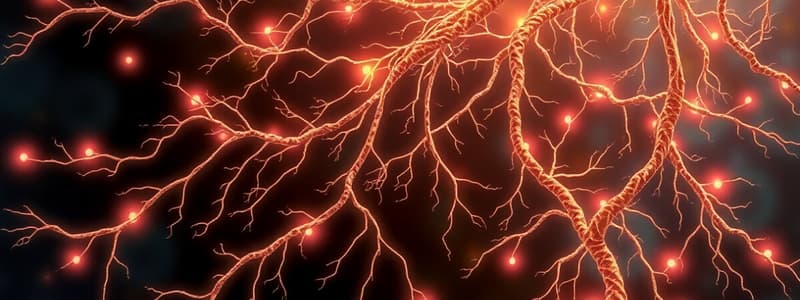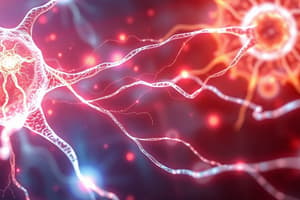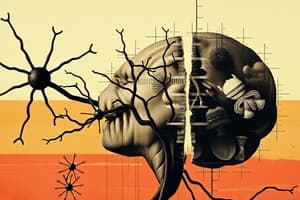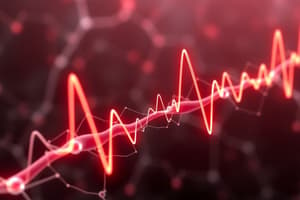Podcast
Questions and Answers
What are the three main functions of the nervous system?
What are the three main functions of the nervous system?
- Central, Peripheral, Autonomic
- Somatic, Autonomic, Enteric
- Sensory, Integrative, Motor (correct)
- Brain, Spinal Cord, Nerves
The central nervous system (CNS) is comprised of the brain and the peripheral nerves.
The central nervous system (CNS) is comprised of the brain and the peripheral nerves.
False (B)
What type of cell is responsible for generating nerve impulses?
What type of cell is responsible for generating nerve impulses?
neurons
The ______ nervous system is responsible for controlling voluntary movements.
The ______ nervous system is responsible for controlling voluntary movements.
Match the following nervous system components with their corresponding functions:
Match the following nervous system components with their corresponding functions:
Action Potentials (AP) are used for communication over both short and long distances.
Action Potentials (AP) are used for communication over both short and long distances.
What type of ion channels respond to direct changes in membrane potential?
What type of ion channels respond to direct changes in membrane potential?
The type of ion channels that randomly open and close are called ______ channels.
The type of ion channels that randomly open and close are called ______ channels.
What are the two types of electrical signals used for communication in excitable cells?
What are the two types of electrical signals used for communication in excitable cells?
Match the type of ion channel with its corresponding stimulus:
Match the type of ion channel with its corresponding stimulus:
Which of the following characteristics is unique to action potentials, but not present in graded potentials?
Which of the following characteristics is unique to action potentials, but not present in graded potentials?
Action potentials can die out as they travel along the axon.
Action potentials can die out as they travel along the axon.
What is the name of the process by which action potentials travel from the trigger zone to the axon terminals?
What is the name of the process by which action potentials travel from the trigger zone to the axon terminals?
The speed of action potential propagation is influenced by factors such as axon ______ and the presence of ______.
The speed of action potential propagation is influenced by factors such as axon ______ and the presence of ______.
Match the following features of action potentials and graded potentials with their corresponding descriptions.
Match the following features of action potentials and graded potentials with their corresponding descriptions.
What are the two types of summation that can occur in nerve impulses?
What are the two types of summation that can occur in nerve impulses?
Enkephalins are known to enhance the perception of pain.
Enkephalins are known to enhance the perception of pain.
What is the primary role of nitric oxide as a neurotransmitter?
What is the primary role of nitric oxide as a neurotransmitter?
Dynorphins are thought to play a role in ______ and registering emotions.
Dynorphins are thought to play a role in ______ and registering emotions.
Match the following neuropeptides with their primary functions:
Match the following neuropeptides with their primary functions:
The ______ enlargement of the spinal cord handles motor output and sensory input to and from the legs.
The ______ enlargement of the spinal cord handles motor output and sensory input to and from the legs.
In the brain, gray matter is found on the outside, while white matter resides on the inside.
In the brain, gray matter is found on the outside, while white matter resides on the inside.
What is the primary function of the posterior (dorsal) root and rootlets of the spinal cord?
What is the primary function of the posterior (dorsal) root and rootlets of the spinal cord?
What is the name of the swelling on the posterior root that contains the cell bodies of sensory neurons?
What is the name of the swelling on the posterior root that contains the cell bodies of sensory neurons?
Match the following structures with their corresponding locations:
Match the following structures with their corresponding locations:
A lumbar puncture is a procedure where a needle is inserted into the subarachnoid space to withdraw cerebrospinal fluid (CSF).
A lumbar puncture is a procedure where a needle is inserted into the subarachnoid space to withdraw cerebrospinal fluid (CSF).
Which of the following is NOT a common reason for performing a lumbar puncture?
Which of the following is NOT a common reason for performing a lumbar puncture?
The site used for most lumbar punctures is between the ___ and ___ lumbar vertebrae.
The site used for most lumbar punctures is between the ___ and ___ lumbar vertebrae.
What is the primary function of spinal nerves?
What is the primary function of spinal nerves?
Match the following connective tissue coverings with their corresponding location:
Match the following connective tissue coverings with their corresponding location:
Which of the following nerve plexuses is responsible for supplying the skin and muscles of the head, neck, superior portion of the shoulders and chest, and diaphragm?
Which of the following nerve plexuses is responsible for supplying the skin and muscles of the head, neck, superior portion of the shoulders and chest, and diaphragm?
The posterior rami of the segmental nerves join together to form major nerve plexuses.
The posterior rami of the segmental nerves join together to form major nerve plexuses.
What is the name of the nerve that provides motor innervation to the diaphragm?
What is the name of the nerve that provides motor innervation to the diaphragm?
The ______ nerve is the most important nerve of the brachial plexus, resulting in carpal tunnel syndrome when lesioned.
The ______ nerve is the most important nerve of the brachial plexus, resulting in carpal tunnel syndrome when lesioned.
Match the following nerve plexuses with their primary areas of innervation.
Match the following nerve plexuses with their primary areas of innervation.
Which of the following injuries could result in a "winged scapula"?
Which of the following injuries could result in a "winged scapula"?
Erb's palsy is a type of brachial plexus injury that typically occurs in infants during childbirth.
Erb's palsy is a type of brachial plexus injury that typically occurs in infants during childbirth.
What is the name of the condition that occurs when the ulnar nerve is compressed at the medial epicondyle of the humerus?
What is the name of the condition that occurs when the ulnar nerve is compressed at the medial epicondyle of the humerus?
Carpal tunnel syndrome is a common type of ______ nerve injury.
Carpal tunnel syndrome is a common type of ______ nerve injury.
Match the following nerves with their primary functions:
Match the following nerves with their primary functions:
Which of the following structures is NOT part of the diencephalon?
Which of the following structures is NOT part of the diencephalon?
The thalamus is the relay station for all sensory impulses, including smell, to the cerebral cortex.
The thalamus is the relay station for all sensory impulses, including smell, to the cerebral cortex.
What is the primary function of the hypothalamus?
What is the primary function of the hypothalamus?
The ______ gland secretes melatonin, which is involved in regulating sleep-wake cycles.
The ______ gland secretes melatonin, which is involved in regulating sleep-wake cycles.
Match the following structures with their primary functions:
Match the following structures with their primary functions:
Which of the following brain wave types is associated with periods of sensory input and mental activity?
Which of the following brain wave types is associated with periods of sensory input and mental activity?
Alpha brain waves are present during sleep.
Alpha brain waves are present during sleep.
What is the name of the recording that measures brain wave activity?
What is the name of the recording that measures brain wave activity?
The ______ waves occur during deep sleep in adults and in awake infants.
The ______ waves occur during deep sleep in adults and in awake infants.
Match the following types of brain waves with their corresponding states:
Match the following types of brain waves with their corresponding states:
What structure in the brain plays a key role in the maintenance of consciousness?
What structure in the brain plays a key role in the maintenance of consciousness?
Which of the following is NOT produced by the hypothalamus?
Which of the following is NOT produced by the hypothalamus?
The corpus callosum connects the right and left hemispheres of the cerebrum.
The corpus callosum connects the right and left hemispheres of the cerebrum.
The ______ lobe of the cerebrum is responsible for processing visual information.
The ______ lobe of the cerebrum is responsible for processing visual information.
Match the following brain structures with their primary functions:
Match the following brain structures with their primary functions:
Which of the following structures protects the brain?
Which of the following structures protects the brain?
The dura mater is composed of a single layer in the brain and spinal cord.
The dura mater is composed of a single layer in the brain and spinal cord.
What is the name of the structure that connects the two hemispheres of the brain?
What is the name of the structure that connects the two hemispheres of the brain?
The _____ arteries and _____ arteries supply blood to the brain.
The _____ arteries and _____ arteries supply blood to the brain.
Match the following brain coverings with their descriptions:
Match the following brain coverings with their descriptions:
Which of the following is NOT a characteristic of the somatic nervous system?
Which of the following is NOT a characteristic of the somatic nervous system?
The autonomic nervous system is primarily responsible for controlling involuntary bodily functions.
The autonomic nervous system is primarily responsible for controlling involuntary bodily functions.
The ______ nervous system is responsible for the 'fight-or-flight' response.
The ______ nervous system is responsible for the 'fight-or-flight' response.
What are the two primary neurotransmitters used by the autonomic nervous system?
What are the two primary neurotransmitters used by the autonomic nervous system?
Match the following autonomic nervous system divisions with their primary functions:
Match the following autonomic nervous system divisions with their primary functions:
Where are the cell bodies of sympathetic preganglionic neurons located?
Where are the cell bodies of sympathetic preganglionic neurons located?
The parasympathetic division has a faster response system than the sympathetic division.
The parasympathetic division has a faster response system than the sympathetic division.
What are the two major types of sympathetic ganglia?
What are the two major types of sympathetic ganglia?
The ______ nerve carries approximately 80% of the parasympathetic flow.
The ______ nerve carries approximately 80% of the parasympathetic flow.
Match the following terms with the correct description:
- Preganglionic neuron
- Postganglionic neuron
- Sympathetic trunk ganglia
- Prevertebral ganglia
A. Lie in a vertical row on either side of the vertebral column
B. Cell body located in an autonomic ganglion
C. Cell body located in the brain or spinal cord
D. Lie anterior to the vertebral column
Match the following terms with the correct description:
- Preganglionic neuron
- Postganglionic neuron
- Sympathetic trunk ganglia
- Prevertebral ganglia
A. Lie in a vertical row on either side of the vertebral column B. Cell body located in an autonomic ganglion C. Cell body located in the brain or spinal cord D. Lie anterior to the vertebral column
What is the primary neurotransmitter released by most sympathetic postganglionic neurons?
What is the primary neurotransmitter released by most sympathetic postganglionic neurons?
The autonomic nervous system always operates under conscious control.
The autonomic nervous system always operates under conscious control.
What are the two main branches of the autonomic nervous system?
What are the two main branches of the autonomic nervous system?
The _________ nervous system controls skeletal muscle contractions.
The _________ nervous system controls skeletal muscle contractions.
Match the following neurotransmitters with their corresponding locations in the autonomic nervous system:
Match the following neurotransmitters with their corresponding locations in the autonomic nervous system:
Which of the following is NOT a characteristic of the parasympathetic nervous system?
Which of the following is NOT a characteristic of the parasympathetic nervous system?
Most autonomic motor pathways consist of two motor neurons in series.
Most autonomic motor pathways consist of two motor neurons in series.
What are the two main divisions of the autonomic nervous system?
What are the two main divisions of the autonomic nervous system?
The ______ nervous system is often referred to as the fight-or-flight division.
The ______ nervous system is often referred to as the fight-or-flight division.
Match the following terms with their corresponding descriptions:
Match the following terms with their corresponding descriptions:
Flashcards
Nervous System Functions
Nervous System Functions
The nervous system has three main functions: sensory, integrative, and motor.
Neurons
Neurons
Neurons are electrically excitable cells that transmit nerve impulses called action potentials.
Action Potential
Action Potential
An action potential is a brief electrical charge in a neuron that propagates along its membrane.
Neuroglia
Neuroglia
Signup and view all the flashcards
Homeostasis
Homeostasis
Signup and view all the flashcards
Graded Potentials
Graded Potentials
Signup and view all the flashcards
Propagation of Action Potentials
Propagation of Action Potentials
Signup and view all the flashcards
Factors Affecting Propagation Speed
Factors Affecting Propagation Speed
Signup and view all the flashcards
Continuous vs. Saltatory Conduction
Continuous vs. Saltatory Conduction
Signup and view all the flashcards
Summation
Summation
Signup and view all the flashcards
Spatial Summation
Spatial Summation
Signup and view all the flashcards
Temporal Summation
Temporal Summation
Signup and view all the flashcards
Neurotransmitters
Neurotransmitters
Signup and view all the flashcards
Neuropeptides
Neuropeptides
Signup and view all the flashcards
Action Potentials (AP)
Action Potentials (AP)
Signup and view all the flashcards
Graded Potentials (GP)
Graded Potentials (GP)
Signup and view all the flashcards
Resting Membrane Potential
Resting Membrane Potential
Signup and view all the flashcards
Ion Channels
Ion Channels
Signup and view all the flashcards
Ligand-gated Channels
Ligand-gated Channels
Signup and view all the flashcards
Lumbar Puncture
Lumbar Puncture
Signup and view all the flashcards
Cerebrospinal Fluid (CSF)
Cerebrospinal Fluid (CSF)
Signup and view all the flashcards
Cauda Equina
Cauda Equina
Signup and view all the flashcards
Spinal Nerves
Spinal Nerves
Signup and view all the flashcards
Perineurium
Perineurium
Signup and view all the flashcards
Lumbar Enlargement
Lumbar Enlargement
Signup and view all the flashcards
White Matter vs. Gray Matter
White Matter vs. Gray Matter
Signup and view all the flashcards
Sensory and Motor Processing
Sensory and Motor Processing
Signup and view all the flashcards
Posterior Root Ganglion
Posterior Root Ganglion
Signup and view all the flashcards
Epidural Anesthesia
Epidural Anesthesia
Signup and view all the flashcards
Long Thoracic Nerve
Long Thoracic Nerve
Signup and view all the flashcards
Erb’s Palsy
Erb’s Palsy
Signup and view all the flashcards
Ulnar Nerve
Ulnar Nerve
Signup and view all the flashcards
Median Nerve Injury
Median Nerve Injury
Signup and view all the flashcards
Serratus Anterior Muscle
Serratus Anterior Muscle
Signup and view all the flashcards
Nerve Plexus
Nerve Plexus
Signup and view all the flashcards
Anterior Ramus
Anterior Ramus
Signup and view all the flashcards
Cervical Plexus
Cervical Plexus
Signup and view all the flashcards
Phrenic Nerve
Phrenic Nerve
Signup and view all the flashcards
Neural Tube
Neural Tube
Signup and view all the flashcards
Cranial Meninges
Cranial Meninges
Signup and view all the flashcards
Circle of Willis
Circle of Willis
Signup and view all the flashcards
Cerebrospinal Fluid
Cerebrospinal Fluid
Signup and view all the flashcards
Falx Cerebri
Falx Cerebri
Signup and view all the flashcards
Cerebellum
Cerebellum
Signup and view all the flashcards
Diencephalon
Diencephalon
Signup and view all the flashcards
Thalamus
Thalamus
Signup and view all the flashcards
Hypothalamus
Hypothalamus
Signup and view all the flashcards
Epithalamus
Epithalamus
Signup and view all the flashcards
Brain Waves
Brain Waves
Signup and view all the flashcards
Electroencephalogram (EEG)
Electroencephalogram (EEG)
Signup and view all the flashcards
Alpha Waves
Alpha Waves
Signup and view all the flashcards
Theta Waves
Theta Waves
Signup and view all the flashcards
Delta Waves
Delta Waves
Signup and view all the flashcards
Cerebral Cortex
Cerebral Cortex
Signup and view all the flashcards
White Matter
White Matter
Signup and view all the flashcards
Basal Nuclei
Basal Nuclei
Signup and view all the flashcards
Limbic System
Limbic System
Signup and view all the flashcards
Autonomic Nervous System (ANS)
Autonomic Nervous System (ANS)
Signup and view all the flashcards
Somatic Nervous System
Somatic Nervous System
Signup and view all the flashcards
Sensory Input in ANS
Sensory Input in ANS
Signup and view all the flashcards
Sympathetic vs. Parasympathetic
Sympathetic vs. Parasympathetic
Signup and view all the flashcards
Neurotransmitters in ANS
Neurotransmitters in ANS
Signup and view all the flashcards
Motor Neuron Pathways
Motor Neuron Pathways
Signup and view all the flashcards
Preganglionic Neurons
Preganglionic Neurons
Signup and view all the flashcards
Autonomic Nervous System Effectors
Autonomic Nervous System Effectors
Signup and view all the flashcards
Interoceptors
Interoceptors
Signup and view all the flashcards
Motor Neurons in ANS
Motor Neurons in ANS
Signup and view all the flashcards
Sympathetic Division Location
Sympathetic Division Location
Signup and view all the flashcards
Parasympathetic Division Characteristics
Parasympathetic Division Characteristics
Signup and view all the flashcards
Types of Autonomic Ganglia
Types of Autonomic Ganglia
Signup and view all the flashcards
Sympathetic Neural Pathway
Sympathetic Neural Pathway
Signup and view all the flashcards
Sympathetic Nervous System
Sympathetic Nervous System
Signup and view all the flashcards
Parasympathetic Nervous System
Parasympathetic Nervous System
Signup and view all the flashcards
Autonomic Motor Pathways
Autonomic Motor Pathways
Signup and view all the flashcards
Study Notes
Nervous Tissue Overview
- The nervous system maintains homeostasis by controlling conditions within limits.
- It is composed of various branches and cell types.
- Nervous tissue includes neurons and neuroglia.
Nervous System Overview
- Sensory neurons receive signals from receptors and transmit them to the central nervous system (CNS).
- Interneurons connect other neurons within the CNS.
- Motor neurons transmit signals from the CNS to effectors (muscles or glands).
Nervous System Organization
- Central Nervous System (CNS): Includes the brain and spinal cord.
- Peripheral Nervous System (PNS): Includes cranial nerves, spinal nerves, enteric plexuses, and sensory receptors.
- The PNS has a sensory division and a motor division.
- The motor division includes the somatic nervous system (skeletal muscles) and the autonomic nervous system (smooth muscles, cardiac muscles, and glands).
- The autonomic nervous system has sympathetic and parasympathetic divisions.
- The motor division includes the somatic nervous system (skeletal muscles) and the autonomic nervous system (smooth muscles, cardiac muscles, and glands).
Functions of the Nervous System
- Sensory: Detects changes through sensory receptors.
- Integrative: Analyzes sensory information, stores aspects, and makes decisions relating to behavior.
- Motor: Responds to stimuli via effectors.
Histology of Nervous Tissue
- Neurons are electrically excitable.
- They transmit nerve impulses.
- Neuroglia are not electrically excitable.
- They support and protect neurons.
- There are 6 kinds of neuroglia (4 in CNS and 2 in PNS).
- Astrocytes, Oligodendrocytes, Microglia, and Ependymal cells are types in the CNS.
- Satellite cells and Schwann cells are types in the PNS.
Neurons
- Neurons are electrically excitable.
- Neurons communicate with each other through action potentials or graded potentials.
- Key features include the cell body, dendrites, and axon.
- The axon may be myelinated for faster conduction.
Structural Classification of Neurons
- Based on the number of processes extending from the cell body.
- Multipolar neurons have several dendrites and one axon.
- Bipolar neurons have one dendrite and one axon.
- Unipolar neurons have a single continuous process that serves as both axon and dendrite.
Types of Neurons
- Sensory/Afferent neurons-Convey information to the CNS.
- Motor/Efferent neurons-Conveys action potential from the CNS.
- Interneurons/Association neurons-Process sensory information and elicit motor response.
Neuroglia
- Neuroglia make up about half the volume of the nervous system.
- Neuroglia can multiply and divide.
Myelination of Neurons
- Myelin is produced by Schwann cells (PNS) and oligodendrocytes (CNS).
- Myelin increases the speed of nerve impulse propagation.
- Myelinated axons are separated by nodes of Ranvier; this is part of saltatory conduction.
Gray Matter vs. White Matter
- Gray matter contains mainly neuron cell bodies and unmyelinated axons.
- White matter contains mainly myelinated axons.
Electrical Signals in Neurons
- Excitable cells communicate through action potentials or graded potentials.
- Action potentials allow communication over short and long distances.
- Graded potentials allow communication over short distances.
Action Potentials
- Action potentials are rapid changes in membrane potential.
- The phases include depolarization and repolarization.
- Action potentials have absolute and relative refractory periods.
- It depends on stimulus strength if an action potential occurs.
Factors Affecting Propagation Speed
- Axon diameter
- Amount of myelination.
- Temperature.
Synapses
- A synapse is the junction between neurons or between a neuron and an effector. -Electrical Synapses: Gap junctions allow direct communication. -Chemical Synapses: One-way transfer via neurotransmitter release.
Postsynaptic Potentials
- Excitatory postsynaptic potentials (EPSPs) are depolarizing potentials.
- Inhibitory postsynaptic potentials (IPSPs) are hyperpolarizing potentials.
Neurotransmitter Receptors
- lonotropic receptors have a binding site and an ion channel.
- Metabotropic receptors have a binding site that activates a G protein coupled to a separate ion channel.
Neurotransmitters
- Small molecule neurotransmitters, including acetylcholine, amino acids, biogenic amines, ATP, nitric oxide, and carbon monoxide.
- Neuropeptides can act as neurotransmitters, such as substance P, enkephalins, endorphins, dynorphins, hypothalamic releasing and inhibiting hormones, angiotensin II, and cholecystokinin & neuropeptide Y.
Summation
- Summation is the combining of the effects of multiple stimuli. This can be spatial (multiple inputs) or temporal (multiple inputs over time).
Neural Circuits
- Neural circuits are functional groups of interconnected neurons.
- Types of neural circuits include simple series, converging, diverging, reverberating, and parallel after-discharge circuits.
Regeneration and Repair of Nervous Tissue
- Neurons have limited ability to regenerate.
- Plasticity and regeneration are factors that influence repair.
- Repair is limited in the CNS but possible in the PNS.
Neural Disorders
- Disorders can include multiple sclerosis (autoimmune, progressive myelin sheath destruction), and depression (major depression, dysthymia, bipolar depression, and seasonal affective disorder).
Other Neural Disorders
- Other disorders include epilepsy, excitotoxicity (caused by high levels of glutamine in the interstitial fluid), and spinal cord compression. Also, traumatic injuries to the spinal cord such as monoplegia, paraplegia, hemiplegia and quadriplegia. Shingles is also listed as a disorder. Poliomyelitis is caused by the poliovirus and is transmitted from person to person.
Studying That Suits You
Use AI to generate personalized quizzes and flashcards to suit your learning preferences.




